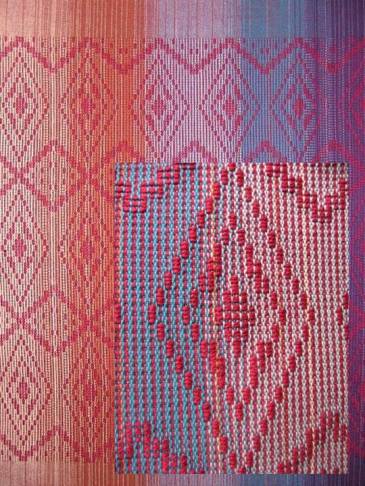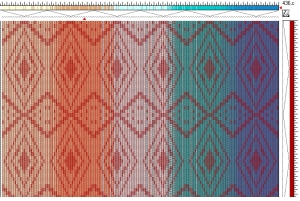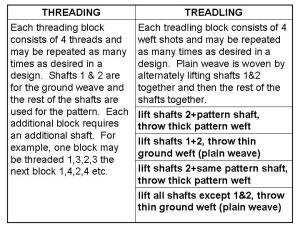After I finished the Summer & Winter Table Runner, I decided to weave something that would look very different but make use of the threading that was already on the loom by tying on a new warp. The same threading for a traditional type of S&W can be used to weave in Dukagang-fashion, as in the Scandinavian inlay weave. There’s an excellent chapter on the many S&W weaves, including Dukagang, in A Weaver’s Book of 8-Shaft Patterns, edited by Carol Strickler, Chapter 15.
Below are images and weaving drafts of the finished woven fabric with some additional notes. I plan to make a pillow from this fabric and I wove part of it in plain weave to use for the back of the pillow.
Additional Notes
The sett is 36 e.p.i. and 30 p.p.i. (the plain weave yardage); 5 colors of 20/2 cotton each wound in a separate warp and “mixed” by eye when tying on to the old warp so one color sort of blends into the next; 20/2 cotton for the plain weave weft and 5/2 pearl cotton for the pattern weft. The fabric was finished by washing by hand and ironing while still slightly damp. Overall shrinkage is about 8%.
It’s a bit narrower than the Table Runner because I removed the side warp ends that were used for the border and the pattern threads were on shaft #3. However, the weaving drafts above do incorporate shaft #3 because I think it would look better this way even though I wove the fabric without it since I was tying on to the old warp. The difference is hardly noticeable.
In the threading and treadling chart you can see that treadling Dukagang-fashion is different in that only one of the tie-down (plain weave) shafts is lifted for all the pattern weft shots while the other shaft is always down. This way the pattern wefts produce the vertical columns. It looks best if each treadling block is repeated at least twice.
When this type of weave is woven on a treadle loom with many shafts tied to one treadle it’s difficult to weave without some kind of device that assists in the lifting. I weave only short yardages and do the best I can with the tie-up to make it as easy as possible to lift when I do this type of weaving on my Macomber.





